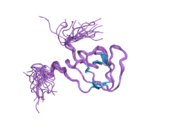PEX13
Peroxisomal membrane protein PEX13 is a protein that in humans is encoded by the PEX13 gene.[5][6] It located on chromosome 2 next to KIAA1841
Interactions
PEX13 has been shown to interact with PEX14,[7] PEX5[7][8] and PEX19.[9][10]
References
- 1 2 3 GRCh38: Ensembl release 89: ENSG00000162928 - Ensembl, May 2017
- 1 2 3 GRCm38: Ensembl release 89: ENSMUSG00000020283 - Ensembl, May 2017
- ↑ "Human PubMed Reference:".
- ↑ "Mouse PubMed Reference:".
- ↑ Bjorkman J, Stetten G, Moore CS, Gould SJ, Crane DI (February 1999). "Genomic structure of PEX13, a candidate peroxisome biogenesis disorder gene". Genomics. 54 (3): 521–8. doi:10.1006/geno.1998.5520. PMID 9878256.
- ↑ "Entrez Gene: PEX13 peroxisome biogenesis factor 13".
- 1 2 Otera, Hidenori; Setoguchi Kiyoko; Hamasaki Maho; Kumashiro Toshitaka; Shimizu Nobuhiro; Fujiki Yukio (March 2002). "Peroxisomal Targeting Signal Receptor Pex5p Interacts with Cargoes and Import Machinery Components in a Spatiotemporally Differentiated Manner: Conserved Pex5p WXXXF/Y Motifs Are Critical for Matrix Protein Import". Mol. Cell. Biol. United States. 22 (6): 1639–55. doi:10.1128/MCB.22.6.1639-1655.2002. ISSN 0270-7306. PMC 135613. PMID 11865044.
- ↑ Gould, S J; Kalish J E; Morrell J C; Bjorkman J; Urquhart A J; Crane D I (October 1996). "Pex13p is an SH3 protein of the peroxisome membrane and a docking factor for the predominantly cytoplasmic PTs1 receptor". J. Cell Biol. UNITED STATES. 135 (1): 85–95. doi:10.1083/jcb.135.1.85. ISSN 0021-9525. PMC 2121023. PMID 8858165.
- ↑ Sacksteder, K A; Jones J M; South S T; Li X; Liu Y; Gould S J (March 2000). "Pex19 Binds Multiple Peroxisomal Membrane Proteins, Is Predominantly Cytoplasmic, and Is Required for Peroxisome Membrane Synthesis". J. Cell Biol. UNITED STATES. 148 (5): 931–44. doi:10.1083/jcb.148.5.931. ISSN 0021-9525. PMC 2174547. PMID 10704444.
- ↑ Fransen, M; Wylin T; Brees C; Mannaerts G P; Van Veldhoven P P (July 2001). "Human Pex19p Binds Peroxisomal Integral Membrane Proteins at Regions Distinct from Their Sorting Sequences". Mol. Cell. Biol. United States. 21 (13): 4413–24. doi:10.1128/MCB.21.13.4413-4424.2001. ISSN 0270-7306. PMC 87101. PMID 11390669.
Further reading
- Gould SJ, Kalish JE, Morrell JC, et al. (1996). "Pex13p is an SH3 protein of the peroxisome membrane and a docking factor for the predominantly cytoplasmic PTs1 receptor". J. Cell Biol. 135 (1): 85–95. doi:10.1083/jcb.135.1.85. PMC 2121023. PMID 8858165.
- Albertini M, Rehling P, Erdmann R, et al. (1997). "Pex14p, a peroxisomal membrane protein binding both receptors of the two PTS-dependent import pathways". Cell. 89 (1): 83–92. doi:10.1016/S0092-8674(00)80185-3. PMID 9094717.
- Fransen M, Terlecky SR, Subramani S (1998). "Identification of a human PTS1 receptor docking protein directly required for peroxisomal protein import". Proc. Natl. Acad. Sci. U.S.A. 95 (14): 8087–92. Bibcode:1998PNAS...95.8087F. doi:10.1073/pnas.95.14.8087. PMC 20933. PMID 9653144.
- Girzalsky W, Rehling P, Stein K, et al. (1999). "Involvement of Pex13p in Pex14p Localization and Peroxisomal Targeting Signal 2–dependent Protein Import into Peroxisomes". J. Cell Biol. 144 (6): 1151–62. doi:10.1083/jcb.144.6.1151. PMC 2150583. PMID 10087260.
- Shimozawa N, Suzuki Y, Zhang Z, et al. (1999). "Nonsense and temperature-sensitive mutations in PEX13 are the cause of complementation group H of peroxisome biogenesis disorders". Hum. Mol. Genet. 8 (6): 1077–83. doi:10.1093/hmg/8.6.1077. PMID 10332040.
- Toyama R, Mukai S, Itagaki A, et al. (2000). "Isolation, characterization and mutation analysis of PEX13-defective Chinese hamster ovary cell mutants". Hum. Mol. Genet. 8 (9): 1673–81. doi:10.1093/hmg/8.9.1673. PMID 10441330.
- Liu Y, Björkman J, Urquhart A, et al. (1999). "PEX13 is mutated in complementation group 13 of the peroxisome-biogenesis disorders". Am. J. Hum. Genet. 65 (3): 621–34. doi:10.1086/302534. PMC 1377968. PMID 10441568.
- Sacksteder KA, Jones JM, South ST, et al. (2000). "Pex19 Binds Multiple Peroxisomal Membrane Proteins, Is Predominantly Cytoplasmic, and Is Required for Peroxisome Membrane Synthesis". J. Cell Biol. 148 (5): 931–44. doi:10.1083/jcb.148.5.931. PMC 2174547. PMID 10704444.
- Fransen M, Wylin T, Brees C, et al. (2001). "Human Pex19p Binds Peroxisomal Integral Membrane Proteins at Regions Distinct from Their Sorting Sequences". Mol. Cell. Biol. 21 (13): 4413–24. doi:10.1128/MCB.21.13.4413-4424.2001. PMC 87101. PMID 11390669.
- Jones JM, Morrell JC, Gould SJ (2001). "Multiple Distinct Targeting Signals in Integral Peroxisomal Membrane Proteins". J. Cell Biol. 153 (6): 1141–50. doi:10.1083/jcb.153.6.1141. PMC 2192020. PMID 11402059.
- Otera H, Setoguchi K, Hamasaki M, et al. (2002). "Peroxisomal Targeting Signal Receptor Pex5p Interacts with Cargoes and Import Machinery Components in a Spatiotemporally Differentiated Manner: Conserved Pex5p WXXXF/Y Motifs Are Critical for Matrix Protein Import". Mol. Cell. Biol. 22 (6): 1639–55. doi:10.1128/MCB.22.6.1639-1655.2002. PMC 135613. PMID 11865044.
- Fransen M, Brees C, Ghys K, et al. (2002). "Analysis of mammalian peroxin interactions using a non-transcription-based bacterial two-hybrid assay". Mol. Cell. Proteomics. 1 (3): 243–52. doi:10.1074/mcp.M100025-MCP200. PMID 12096124.
- Strausberg RL, Feingold EA, Grouse LH, et al. (2003). "Generation and initial analysis of more than 15,000 full-length human and mouse cDNA sequences". Proc. Natl. Acad. Sci. U.S.A. 99 (26): 16899–903. Bibcode:2002PNAS...9916899M. doi:10.1073/pnas.242603899. PMC 139241. PMID 12477932.
- Fransen M, Vastiau I, Brees C, et al. (2004). "Potential role for Pex19p in assembly of PTS-receptor docking complexes". J. Biol. Chem. 279 (13): 12615–24. doi:10.1074/jbc.M304941200. PMID 14715663.
- Gerhard DS, Wagner L, Feingold EA, et al. (2004). "The Status, Quality, and Expansion of the NIH Full-Length cDNA Project: The Mammalian Gene Collection (MGC)". Genome Res. 14 (10B): 2121–7. doi:10.1101/gr.2596504. PMC 528928. PMID 15489334.
- Hashimoto K, Kato Z, Nagase T, et al. (2005). "Molecular mechanism of a temperature-sensitive phenotype in peroxisomal biogenesis disorder". Pediatr. Res. 58 (2): 263–9. doi:10.1203/01.PDR.0000169984.89199.69. PMID 16006427.
- Nguyen T, Bjorkman J, Paton BC, Crane DI (2006). "Failure of microtubule-mediated peroxisome division and trafficking in disorders with reduced peroxisome abundance". J. Cell Sci. 119 (Pt 4): 636–45. doi:10.1242/jcs.02776. PMID 16449325.
External links
- GeneReviews/NCBI/NIH/UW entry on Peroxisome Biogenesis Disorders, Zellweger Syndrome Spectrum
- OMIM entries on Peroxisome Biogenesis Disorders, Zellweger Syndrome Spectrum
This article is issued from
Wikipedia.
The text is licensed under Creative Commons - Attribution - Sharealike.
Additional terms may apply for the media files.






